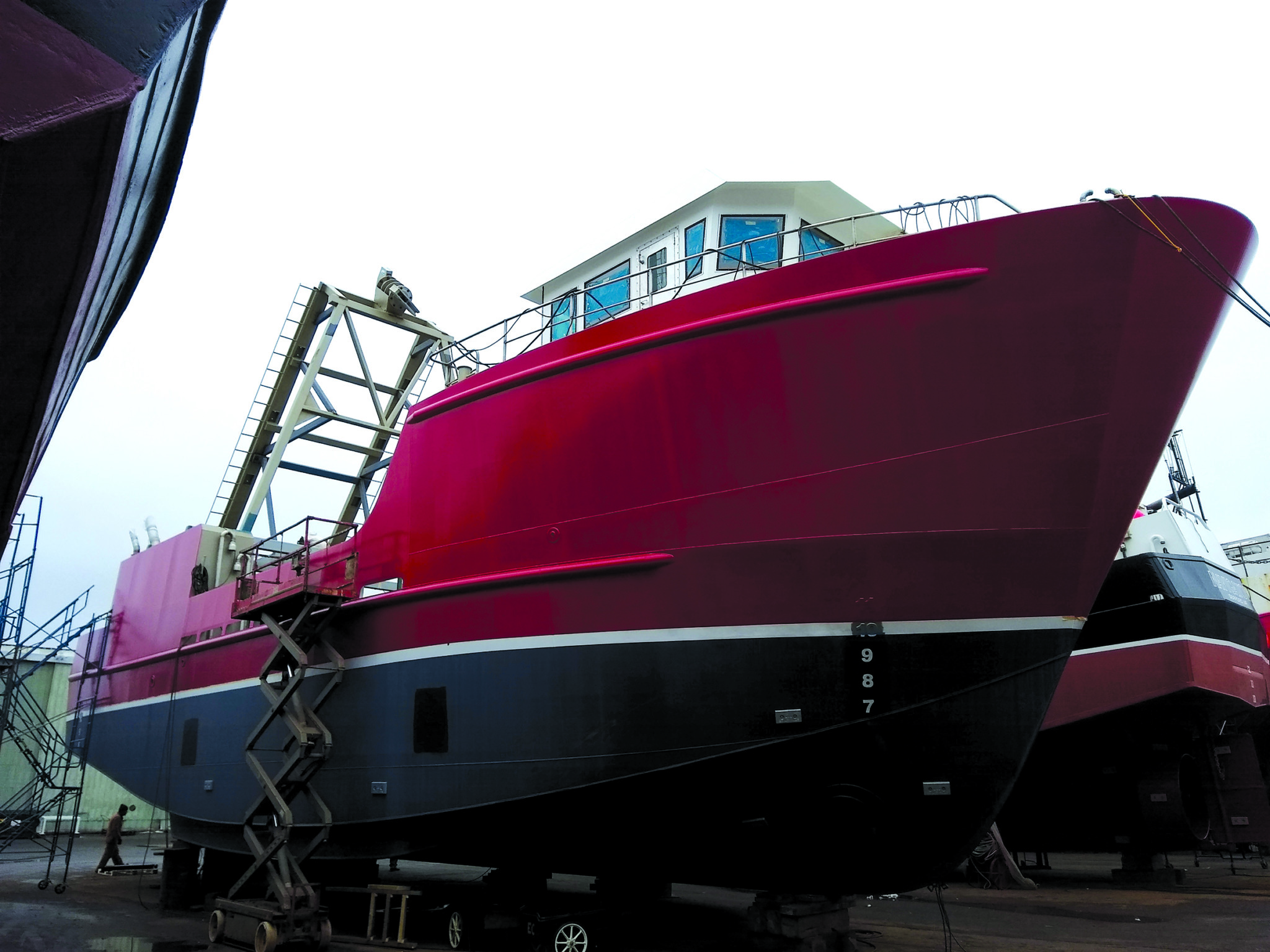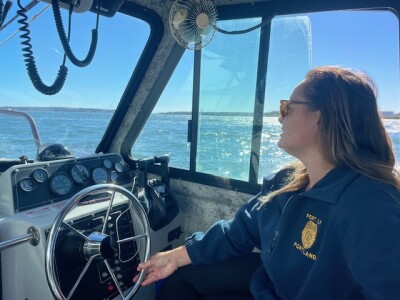New Jersey clamming family ready to launch the F/V Joey D at Fairhaven Shipyard in Massachusetts
Increasing efficiency and cutting costs are the main drivers behind Oceanside Marine’s new clam boat, the Joey D. “It’s named after my grandson,” says company co-owner Danny LaVecchia.
LaVecchia and his brother Michael, of Oceanside Marine, hired the Maine-based naval architects Farrell and Norton to design an efficient boat to harvest clams for their processing company, LaMonica Fine Foods. The brothers also hired Captain Tom Dameron of Last Tow LLC to work on dredge design and help specify vessel equipment and manage the project, with marine inspections during the building being conducted by Mike Collyer of Marine Safety Consultants.
“We just listened to what he wanted and worked within the regulations,” says naval architect Tom Farrell. “The Tier 4 and the ABS standards are what we had to think about.”
Fairhaven Shipyard in Fairhaven, Mass., is building the 79-foot steel boat. “They laid the keel in February of last year,” says Farrell. “We were talking to Danny for a year or so before that.”
The LaVecchia brothers talked to several shipbuilders up and down the East Coast. Once they visited Kevin McLaughlin at Fairhaven Shipyard and saw the quality and craftsmanship of another similar vessel being built at the time, they knew this was a good fit. Matt Stommel leads the team building the Joey D.
LaVecchia wanted a boat that could carry 44 cages — 3' x 4' x 5' steel cages that hold 32 bushels of clams — and avoid new regulations that require engines over 804-hp to conform to Tier 4 emissions standards, which often require space consuming after-treatment systems. “We came up with a 79-foot boat for him,” says Farrell. “He chose the 800-hp QSK 19,” says Farrell. “It came down to that or the Mitsubishi. Cummins had the best price.”
The Cummins turns a Twin Disc MGX-5222 Quick Shift Marine Transmission with a 6:1 ratio to a 5-inch diameter Aquamet 17 stainless steel shaft, and a five-blade propeller. In addition, the Joey D is equipped with an 18-inch bow thruster.
The Joey D has two Cummins 125-kW gensets for the electric pumps used in the hydraulic and RSW systems, and for other electric demands on the vessel.
The layout of the Joey D has the engine room aft of the clam hold, which separates it from the fo’c’sle, and adds to crew comfort. Ballast tanks forward help keep the vessel trim when she is running empty. Because of the vessel’s beam, the boat was designed without outriggers and is outfitted with substantial rolling chocks.
Airline Hydraulics designed and installed the hydraulics system that runs the Twin Staffa 700 winch to set and haul the dredge as well as bring the dredge up the A-frame — commonly known as a rocket launcher because of its appearance. Included in the deck equipment is a state of the art Simplicity 3' x 5' Clam Shaker, sized to shake out small clams and other extraneous material and to return it to the ocean, while sending market size clams into a hopper on deck. The crew guides conveyors that take the clams from the hopper to cages located in the hold.
“We tow a 100-inch dredge,” LaVecchia says. He notes that although there are no regulations on dredge size, Oceanside Marine chose to keep the dredge on the small side of industry standards. Clam boats tow hydraulic dredges through high-energy sand. In order to dislodge surf clams or quahogs below the surface, the boats pump water into the sand ahead of the dredge. “We’ve got a 600-hp Cummins to drive the pump,” says LaVecchia. Like many boats in the fishery, the Joey D has a Goulds stainless steel pump, forcing seawater through an 8-inch-diameter hose into the manifold. “It’s pretty much industry standard,” he says.
Clam boats haul the dredge onto the A-frame, and the clams are dumped into the clam hopper, making their way into the shaker for washing, sorting and then into the cages in the hold.
On the Joey D a refrigerated seawater system built by IMS in Seattle will keep the clams refrigerated. “The RSW is a spray system, which is healthier for the clams than immersing in water,” says LaVecchia. “We have stainless tubes running along above the cages which we atomize a cool spray over the clams, keeping them chilled.” The Joey D will make 36- to 48-hour trips, fishing primarily off the Jersey Shore and Delmarva Peninsula.
The wheelhouse will feature a suite of electronics provided by Martek of Avalon, N.J. Communications will be handled by two Icom M506-01 VHFs with 21-foot Shakespeare Big Stick antennas.
The Furuno FR-1945,10.4 Color LCD 64-nm radar and DRS6ANXT 25-watt, 72-nm solid state radar with touchscreen display will assist with long- and short-range lookout. The Furuno package, including an FCV 295 sounder, a DFF3D multi-beam 3-D sonar, a DFF1-UHD CHIRP sounder, and a DFF3D multi-beam 3-D sonar that will help the skipper locate productive areas. Two Busware Computers with 17-inch monitor systems running Radar-Comm P-Sea WindPlot software, a 3-D WindPlot Program, and SeaBed Builder Program along with Nobeltec TZ-108 TZ Professional Plotter Software will help keep the vessel on tow. An Intellian I4 satellite TV system will keep the crew entertained during transit to and from the grounds.
Oceanside Marine has five boats: the Jersey Devil, the Nicole Danielle, the Michael Junior, the Mary Vee, and the Lauren Kim. LaVecchia will retire the oldest, the Lauren Kim, when he puts the Joey D into service. Most of the other boats are close to or over 100 feet.
“Since we are a hand-shucking operation,” says LaVecchia, “we really don’t require boats that big. Smaller boats provide what we need while being more fuel efficient. We want to do our part to conserve fuel.”
While the boat has accommodations for nine — a captain’s stateroom and four-person crew person stateroom on the main deck and a four-person stateroom below deck — the vessel will carry a crew of four, LaVecchia says.
Like the rest of the Oceanside Marine fleet, the Joey D will land in Atlantic City, N.J. A tractor trailer can carry 14 cages, LaVecchia points out, and the Joey D will load about three trucks. Oceanside Marine supplies surf clam shellstock mainly to New Jersey’s LaMonica Fine Foods, as well as other clam shucking companies. “It’s about an hour to the LaMonica Fine Foods plant in Millville,” says LaVecchia.
“Our family started in the seafood business in 1923,” he says. “We were primarily processors. We got into fishing for surf clams in the 1980s.” According to LaVecchia, the sea clam fishery came under individual transferable quota management in 1990 and was the first U.S. fishery to use ITQs.
“We had our boats, and as older fishermen retired, we bought their boats and quota,” says LaVecchia. “Now we hold approximately 17 percent of the quota.” That translates to more than half a million bushels of surf clams.
With the supply of shellstock from Oceanside Marine and a state of the art processing plant, LaMonica Fine Foods has become a vertically integrated company that produces a variety of clam and seafood products.
According to NMFS: “For fishing year 2019 (Jan. 1–Dec. 31, 2019), the quota will remain 3.4 million bushels for surf clams, 5.33 million bushels for ocean quahogs, and 100,000 Maine bushels for Maine ocean quahogs. These quotas are unchanged from fishing year 2018.”
The LaVecchia family will soon celebrate a century in the seafood business, and they want to keep it healthy for coming generations. Danny LaVecchia makes it clear: “We want to stay well connected to the scientific and industry organizations to ensure that Oceanside Marine, as well as all stakeholders and ocean users are doing their part to fish responsibility and use environmentally sound practices throughout the whole supply chain.”
This story was first published in the March 2020 issue of National Fisherman. Subscribe today for digital and print access.







